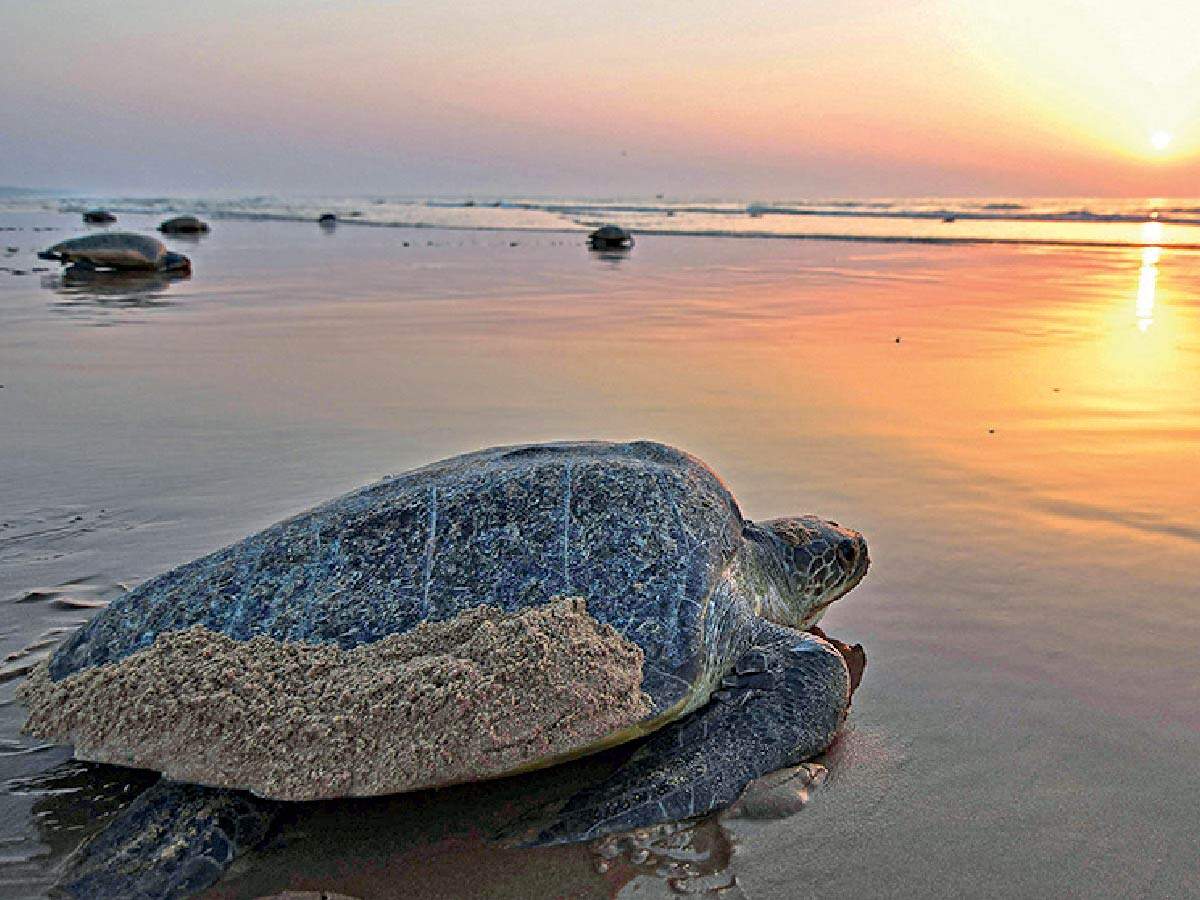
R Suresh Kumar is a wildlife biologist at the department of endangered species management, the Wildlife Institute of India. An expert in migratory Olive Ridley turtles, which swim from Australia to Sri Lanka and India, Kumar shares insights with Times Evoke on how this marine species plans its 9,000 km-long voyage:
The famous Olive Ridley turtle nests along the Indian coastline, which is about 7,500 kilometres long. The Olive Ridley is a tropical to subtropical subspecies, found in warm waters globally. It is fond of India — from the Gujarat coast to the Andamans and Lakshadweep to Odisha and Bengal, this species nests here annually. It journeys from foraging grounds off Australia to Sri Lanka and India, covering 9,000 kilometres.

AS THE TIDE TURNS: Olive Ridley turtles keenly follow nature’s cues. (Photo courtesy: Getty Images)
Odisha has the right kind of nesting beaches, located by river mouths. The eastern coast, criss crossed by the Kaveri in the south to the Ganga up north, is rich in river systems. These have deltaic areas with sandpits, which nesting turtles like.
Turtles also seek a specific latitude. As you move away from the Equator, the higher up you go, it gets colder while lower down, it becomes warmer. Olive Ridleys look for a beach environment located along a latitude of 25 degrees. This is possibly why their only other mass nesting, called arribada nesting, which takes place in the thousands, is seen around Costa Rica and Mexico, both of which are similar to Odisha.
But how Olive Ridleys know all this is a mystery. Their sense of magnetic fields is clearly very strong. Closer to the poles, the magnetic fields are dense and narrow while nearer the Equator, these are far apart. Turtles can understand the magnetic field. Remarkably, turtles have a sense of the chemical composition of their natal beaches as well. Hatchlings from one beach are led back by olfactory cues almost 15 years later to the same place!
Olive Ridleys display collective migratory behaviour. About 1,50,000 turtles move at a time. Small batches converge, starting migration simultaneously. The group swims to the waters around their natal beach. One day, a ‘trigger’ makes them emerge together and start nesting. How do they decide this synchronised emergence? They use environmental cues — sea currents, the sun’s position, surface winds, temperature, seasons and the moon.

Even the hatchlings depend on these to start swimming together one day. They have no parental guidance since adult turtles usually leave their eggs and swim away. The hatchlings make their own way to the foraging grounds, guided by environmental cues — Olive Ridleys are practically programmed by nature to sense signs like a displacement of water in ocean currents. As the monsoon recedes, and the winter starts to set in, ocean currents change. The turtles just need to hop onto these currents, which transport them over vast areas. Olive Ridleys know how to fall in line with nature — it carries them safely to ideal locations.
The famous Olive Ridley turtle nests along the Indian coastline, which is about 7,500 kilometres long. The Olive Ridley is a tropical to subtropical subspecies, found in warm waters globally. It is fond of India — from the Gujarat coast to the Andamans and Lakshadweep to Odisha and Bengal, this species nests here annually. It journeys from foraging grounds off Australia to Sri Lanka and India, covering 9,000 kilometres.

AS THE TIDE TURNS: Olive Ridley turtles keenly follow nature’s cues. (Photo courtesy: Getty Images)
Odisha has the right kind of nesting beaches, located by river mouths. The eastern coast, criss crossed by the Kaveri in the south to the Ganga up north, is rich in river systems. These have deltaic areas with sandpits, which nesting turtles like.
Turtles also seek a specific latitude. As you move away from the Equator, the higher up you go, it gets colder while lower down, it becomes warmer. Olive Ridleys look for a beach environment located along a latitude of 25 degrees. This is possibly why their only other mass nesting, called arribada nesting, which takes place in the thousands, is seen around Costa Rica and Mexico, both of which are similar to Odisha.
But how Olive Ridleys know all this is a mystery. Their sense of magnetic fields is clearly very strong. Closer to the poles, the magnetic fields are dense and narrow while nearer the Equator, these are far apart. Turtles can understand the magnetic field. Remarkably, turtles have a sense of the chemical composition of their natal beaches as well. Hatchlings from one beach are led back by olfactory cues almost 15 years later to the same place!
Olive Ridleys display collective migratory behaviour. About 1,50,000 turtles move at a time. Small batches converge, starting migration simultaneously. The group swims to the waters around their natal beach. One day, a ‘trigger’ makes them emerge together and start nesting. How do they decide this synchronised emergence? They use environmental cues — sea currents, the sun’s position, surface winds, temperature, seasons and the moon.

Even the hatchlings depend on these to start swimming together one day. They have no parental guidance since adult turtles usually leave their eggs and swim away. The hatchlings make their own way to the foraging grounds, guided by environmental cues — Olive Ridleys are practically programmed by nature to sense signs like a displacement of water in ocean currents. As the monsoon recedes, and the winter starts to set in, ocean currents change. The turtles just need to hop onto these currents, which transport them over vast areas. Olive Ridleys know how to fall in line with nature — it carries them safely to ideal locations.
Download
The Times of India News App for Latest India News

Coronavirus outbreak
Trending Topics
LATEST VIDEOS
India
 It's a first - a 2nd chance to crack H-1B lottery odds
It's a first - a 2nd chance to crack H-1B lottery odds  I-Day 2020: PM Modi recalls the sacrifices of our freedom fighters
I-Day 2020: PM Modi recalls the sacrifices of our freedom fighters  Independence Day 2020: PM Narendra Modi hoists tricolour at Red Fort
Independence Day 2020: PM Narendra Modi hoists tricolour at Red Fort  LAC row: Indian envoy to China meets PLA brass, seeks restoration of status quo
LAC row: Indian envoy to China meets PLA brass, seeks restoration of status quo  Independence Day 2020: PM Modi addresses nation
Independence Day 2020: PM Modi addresses nation  Independence Day 2020: PM Modi receives guard of honour at Red Fort
Independence Day 2020: PM Modi receives guard of honour at Red Fort
More from TOI
Navbharat Times
Featured Today in Travel
Quick Links
Coronavirus in MumbaiCoronavirus in KolkataCoronavirus in HyderabadCoronavirus in DelhiCoronavirus in BangaloreCoronavirus symptomsCoronavirus in IndiaWhat is CoronavirusCoronavirus NewsSolar EclipseNPRWhat is NRCCAB BillCAB and NRCRTI BillPodcast newsLok SabhaShiv SenaYSRCPCongressBJP newsUIDAIIndian ArmyISRO newsSupreme Court
Get the app



